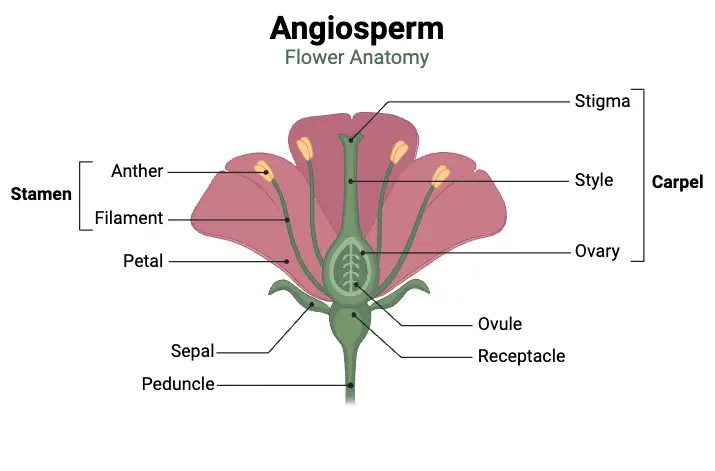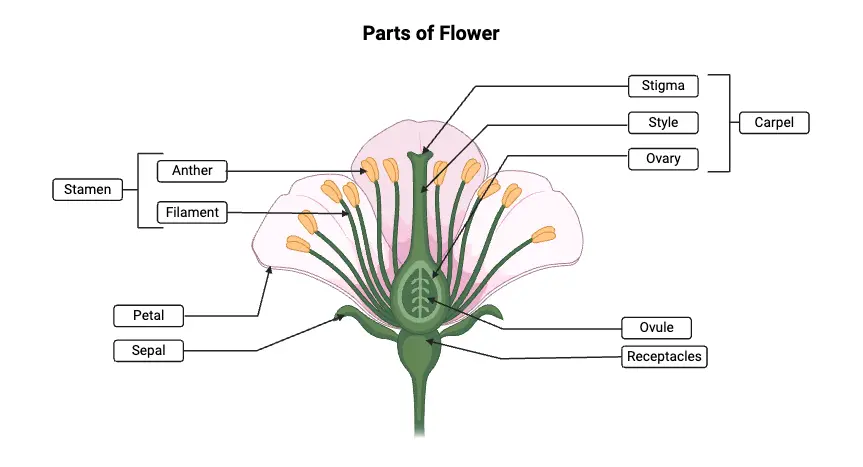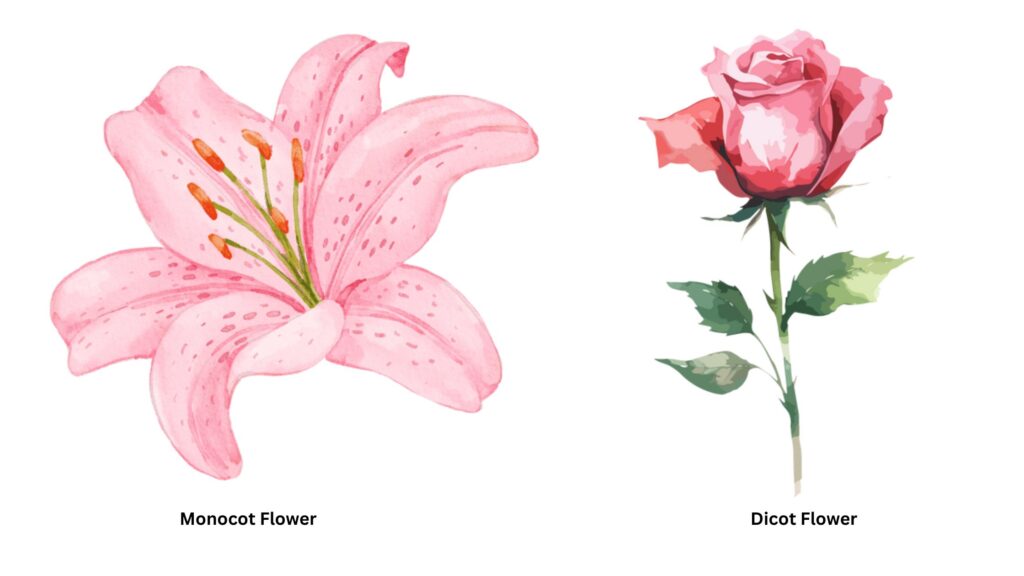What is Monocot Flower?
- Monocot flowers are specialized structures located at condensed shoot regions, primarily functioning in sexual reproduction. Their design is optimized to facilitate this essential biological process, showcasing a unique arrangement of floral components that sets them apart from dicot flowers.
- A defining characteristic of monocot flowers is their floral architecture, which typically features parts that appear in threes or in multiples of three. This arrangement serves as a key differentiating factor between monocots and dicots, allowing botanists and students alike to classify plants accurately. Despite the overarching pattern of floral parts being consistent across monocot species, the diversity in color, size, form, and anatomical arrangement is substantial among different varieties. This variability not only contributes to the aesthetic appeal of monocot flowers but also plays a critical role in their reproductive strategies.
- Structurally, monocot flowers consist of both vegetative and reproductive parts. The vegetative components, including the calyx and corolla, perform vital functions such as protecting the reproductive structures and attracting pollinators. In many cases, these flowers rely primarily on abiotic factors, such as wind and water, for pollination. This reliance is often due to their smaller size and lightweight nature, which facilitates dispersal.
- In some instances, monocot flowers exhibit an undifferentiated calyx and corolla, collectively referred to as the perianth. This adaptation may contribute to their reproductive efficiency in certain environments. Furthermore, most monocot flowers are complete, possessing all four essential floral members: sepals, petals, stamens, and carpels. However, the number and arrangement of these parts can vary significantly among species, reflecting evolutionary adaptations to diverse ecological niches.
- The point of origin for flowers on the stem is termed the bract, which serves to support the floral structure. The size and prominence of the flower itself are influenced by the length of the flower stalk, known as the pedicel. Additionally, the thickened upper portion of the pedicel, referred to as the thalamus, is critical for holding the floral parts. Both the size of the pedicel and the thalamus can vary among different species and even within the same plant, depending on the developmental stage of the flower.

Characteristics of Monocot Flower
Monocot flowers, belonging to the group of flowering plants known as monocotyledons, exhibit several distinctive characteristics that set them apart from dicot flowers. Here are the key features of monocot flowers:
- Floral Part Arrangement: Monocot flowers typically have floral parts that occur in threes or in multiples of three. This arrangement is a primary distinguishing feature, facilitating the differentiation of monocots from dicots.
- Structure: The basic structure of monocot flowers includes vegetative and reproductive components. The vegetative parts, such as the calyx (sepals) and corolla (petals), serve to protect the reproductive structures and attract pollinators.
- Perianth: In some monocot species, the calyx and corolla are undifferentiated, forming a structure called the perianth. This feature contributes to the flower’s overall functionality.
- Pollen Structure: The pollen grains of monocots are typically monosulcate, meaning they have a single furrow or pore. This contrasts with the triporate pollen found in many dicots.
- Flower Composition: Most monocot flowers are considered complete, containing all four essential floral whorls: sepals, petals, stamens, and carpels. However, the arrangement and number of these parts can vary among species.
- Flower Size and Shape: The size, shape, and anatomical arrangement of monocot flowers can vary significantly among species. Some flowers are small and inconspicuous, while others may be larger and more visually striking.
- Pollination Mechanisms: Many monocot flowers rely on wind and water for pollination, particularly because they tend to be smaller and lighter than dicot flowers. However, some species may also attract pollinators through their color and scent.
- Thalamus: The thickened upper part of the flower stalk (pedicel) where the floral parts are attached is called the thalamus. The size and shape of the thalamus can vary based on species and developmental stages.
- Bracts: The structure from which the flowers arise is called the bract. These may vary in size and shape, providing additional support to the flower.
- Symmetry: While monocot flowers often exhibit radial symmetry, they can also display bilateral symmetry, contributing to their overall aesthetic and functional diversity.
What is Dicot Flower?
- A dicot flower represents the reproductive structure of dicotyledonous plants, characterized by specific floral arrangements typically occurring in multiples of four or five. This distinctive feature provides a fundamental means of differentiating dicots from monocots. However, it is important to note that this classification method is not infallible; some plants exhibit variations that can complicate the categorization process, such as reduced flower parts or an abundance of floral elements.
- Most dicot flowers are classified as complete and unisexual, encompassing all four whorls of the flower: sepals, petals, stamens, and carpels. The completeness of these structures ensures that the flowers are fully equipped for reproduction. Furthermore, a notable distinguishing feature of dicot flowers is their triporate pollen structure, which includes three distinct furrows or pores. This specific morphological trait aids in the identification of dicot species and enhances their reproductive capabilities.
- Within dicot plants, there exists considerable variation in the color, shape, symmetry, and size of flowers. The two predominant types of symmetry observed in dicot flowers are radial symmetry, where floral parts radiate from a central point, and bilateral symmetry, which allows for a more asymmetric arrangement. These diverse forms of symmetry contribute to the adaptation of flowers to specific pollinators and environmental conditions.
- The primary function of dicot flowers is sexual reproduction, which drives the evolution of their structures based on the reproductive habits of the respective plants. This adaptability allows dicots to optimize their reproductive success in various ecological niches. Dicot flowers typically arise in the bract region of the stem and are connected to it via the pedicel, a long stalk that provides support for the various floral parts.
- In many cases, dicot flowers rely on pollinators such as insects and animals for reproduction. Their larger size and vibrant colors attract these pollinators, enhancing the chances of successful fertilization. This symbiotic relationship between flowers and their pollinators is crucial for the survival and propagation of many dicot species.
Characteristics of Dicot Flower
Dicot flowers, found in the group of flowering plants known as dicotyledons, exhibit several distinct characteristics that differentiate them from monocot flowers. Below are the key features of dicot flowers:
- Floral Part Arrangement: Dicot flowers typically possess floral parts arranged in multiples of four or five. This characteristic serves as a primary distinguishing factor between dicots and monocots.
- Complete and Unisexual Structure: Most dicot flowers are complete, meaning they contain all four whorls: sepals (calyx), petals (corolla), stamens, and carpels. They can also be unisexual, containing either male or female reproductive structures.
- Pollen Structure: Dicot pollen grains are usually triporate, featuring three distinct furrows or pores. This unique structure aids in the identification of dicot species.
- Variety of Shapes and Sizes: Dicot flowers exhibit a wide range of colors, shapes, sizes, and symmetries, enhancing their appeal and adaptability. The two most common types of symmetry in dicot flowers are radial symmetry (actinomorphic) and bilateral symmetry (zygomorphic).
- Adaptation for Pollination: Many dicot flowers are adapted for pollination by insects and animals. Their larger size and vibrant colors attract pollinators, increasing the likelihood of successful fertilization.
- Bracts and Pedicel: Dicot flowers arise in the bract region of the stem and are attached to it via a long stalk called the pedicel. This stalk provides essential support for the various floral parts.
- Reproductive Functionality: The structure of dicot flowers is often modified to enhance reproductive success based on the plant’s specific reproductive habits. This adaptability allows dicots to thrive in diverse environments.
- Variability Among Species: The color, shape, and size of dicot flowers can vary significantly not only between species but also within the same species. This variability reflects the ecological adaptations of these plants.
- Secondary Growth: Many dicots exhibit secondary growth, leading to the development of thicker stems and larger flowers. This characteristic is less common in monocots.
- Fruit Development: Dicot flowers typically develop into various types of fruit after fertilization, further aiding in seed dispersal and propagation.

Structure of Monocot and Dicot Flower
The structure of monocot and dicot flowers includes various components, each serving distinct functions while adhering to specific morphological patterns that characterize each group. While both types of flowers share fundamental parts, their differences in arrangement and number help distinguish them. Below is a detailed overview of the structural components of monocot and dicot flowers.
- Petal:
- Petals form the corolla, which constitutes the second whorl of a flower, located above the calyx (the first whorl).
- Typically thin and colorful, petals play a crucial role in attracting pollinators, such as animals and insects.
- They may exhibit uniformity in shape and size, classifying flowers as symmetrical, or differ, leading to asymmetrical flowers.
- In certain species, petals may be fused, a condition referred to as gamopetalous.
- Differentiation occurs in the number of petals: dicots generally possess four or five petals or their multiples, while monocots exhibit three petals or multiples of three.
- Stamen:
- The stamen, the male reproductive part of the flower, forms the androecium, the third whorl.
- It comprises two parts: the anther and the filament.
- The anther is the terminal portion that produces and stores microspores or pollen grains, containing microsporangia that develop into pollen.
- Each anther has openings for pollen release, and monocot pollen grains typically have a single furrow, while dicot pollen grains exhibit three distinct furrows.
- The filament is a stalk connecting the anther to other floral parts, with a connective extension that includes vascular tissues.
- Pistil (Carpel):
- The pistil, or carpel, serves as the female reproductive part located at the flower’s center, constituting the innermost whorl.
- It can consist of one or more carpels, forming the gynoecium, which houses the ovary and reproductive gametes.
- Key structures include:
- Stigma: The apical region of the pistil that receives pollen, often sticky or feathery to capture pollen grains.
- Style: A tubular structure that allows pollen tubes to grow, facilitating the passage of pollen from the stigma to the ovary.
- Ovary: The swollen base that contains ovules within a chamber known as the locule, where fertilization occurs.
- Sepal:
- Sepals comprise the calyx, the outermost whorl of the flower, which protects the developing bud and supports the flower during blooming.
- Like petals, sepals are modified leaves and may collectively form a perianth with petals.
- The number of sepals, referred to as its merosity, helps in plant differentiation.
- In some instances, sepals and petals may exhibit similar coloration, leading to the term “tepal.”
- Receptacle:
- The receptacle, or torus, is the swollen part of the pedicel to which all floral parts are attached.
- In certain species, it may contribute to fruit development, while in others, it may reduce in size after fertilization.
- Pedicel/Peduncle:
- The pedicel is the stalk connecting the flower to the stem, comprising the same tissue structure as the stem.
- Flowers without a pedicel are classified as sessile, directly attached to the stem or branches.

Examples of Monocot and Dicot Flower
Monocot and dicot flowers represent two distinct groups of flowering plants, each with unique characteristics and examples. Below is a list of notable examples from both categories:
Examples of Monocot Flowers
- Lily (Lilium spp.): Known for their large, vibrant blooms and elongated petals, lilies are often found in gardens and floral arrangements.
- Orchid (Orchidaceae): This diverse family includes numerous species with complex flower structures, making them highly attractive to pollinators.
- Tulip (Tulipa spp.): Tulips are famous for their cup-shaped flowers and are popular in spring gardens, typically blooming in various colors.
- Iris (Iris spp.): Irises have distinctive, flat petals and can be found in various colors; they are often used in landscaping.
- Grass Flower (Poaceae): Many grasses produce small, inconspicuous flowers that are wind-pollinated, contributing to the ecosystem as a vital food source for various animals.
Examples of Dicot Flowers
- Rose (Rosa spp.): Known for their fragrant blooms and intricate petal arrangements, roses are popular in gardens and as ornamental plants.
- Sunflower (Helianthus annuus): Sunflowers are characterized by their large, round flower heads and are known for their ability to track the sun throughout the day.
- Daisy (Bellis perennis): Daisies have a simple structure with white petals surrounding a yellow center, making them common in lawns and gardens.
- Carnation (Dianthus caryophyllus): These flowers are known for their frilled petals and come in various colors; they are commonly used in bouquets and floral arrangements.
- Maple (Acer spp.): Maple trees produce small flowers that are often overlooked, yet they play a critical role in the tree’s reproductive cycle.

Functions of Monocot and Dicot Flower
Below are the primary functions of monocot and dicot flowers:
- Attraction of Pollinators:
- The diverse colors and shapes of flowers are primarily designed to attract various pollinators, such as insects and animals.
- By utilizing visual and olfactory cues, flowers ensure effective pollination, which is vital for successful reproduction.
- Reproductive Role:
- Flowers contain the reproductive units of the plant, which are essential for sexual reproduction.
- They house both male (stamens) and female (pistils) reproductive structures, facilitating the fertilization process and the production of seeds.
- Cultural Significance:
- In various cultures, flowers hold ornamental value and are frequently used as decorative items during celebrations, rituals, and other significant events.
- Their aesthetic appeal enhances human experiences and connects cultural practices with the natural world.
- Nectar Production:
- Many flowers produce nectar, a sugary fluid that serves as food for pollinators.
- This interaction benefits both parties: insects receive nourishment while assisting in the transfer of pollen grains from one flower to another, thereby promoting cross-pollination.
- Fruit Formation:
- Following successful pollination and fertilization, flowers lead to the development of fruits.
- Fruits serve as a source of food and nutrients, not only for the plant itself but also for animals and humans, which further aids in seed dispersal and the continuation of plant species.
- https://www.nrcs.usda.gov/plantmaterials/flpmctn12686.pdf
- https://www.visiblebody.com/learn/biology/monocot-dicot/overview
- https://amrita.olabs.edu.in/?brch=15&cnt=1&sim=139&sub=79
- https://www-archiv.fdm.uni-hamburg.de/b-online/library/onlinebio/BioBookPLANTANATII.html
- https://socratic.org/questions/how-are-monocot-and-dicot-flowers-different
- https://byjus.com/biology/difference-between-monocotyledon-and-dicotyledon/
- https://byjus.com/biology/monocot-dicot-plants-anatomy/
- Text Highlighting: Select any text in the post content to highlight it
- Text Annotation: Select text and add comments with annotations
- Comment Management: Edit or delete your own comments
- Highlight Management: Remove your own highlights
How to use: Simply select any text in the post content above, and you'll see annotation options. Login here or create an account to get started.